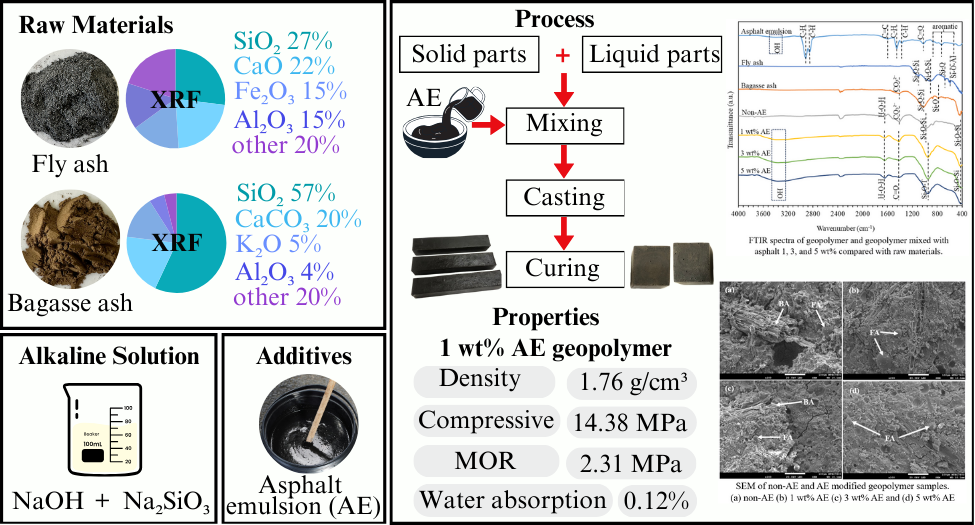The effect of asphalt emulsion on the properties of fly ash based geopolymers
DOI:
https://doi.org/10.55713/jmmm.v35i2.2182Keywords:
geopolymer, fly ash, Bagasse ash, asphalt emulsion, compressive strengthAbstract
This research aimed to study the effect of asphalt emulsion (AE) on the properties of fly ash based geopolymers. Solid waste materials used for the production of geopolymer were coal fly ash (FA) 70 wt% and bagasse ash (BA) 30 wt%. Alkaline solution used for the geopolymerization reaction was the mixture of 10 M NaOH and Na
2SiO
3with the ratio of 1:2. The liquid and solid (L/S) ratios of 0.6, 0.7 and 0.8 were prepared. The AE of 1 wt%, 3 wt% and 5 wt% were added into the raw materials mixtures. Then, the mixed slurry was casted into a mold for the further tests. The setting time was determined using VICAT. After ageing of 7 day, 14 day, and 28 day, the compressive strength and modulus of rupture (MOR) samples were measured. The results of the study revealed that the sample with the L/S ratio of 0.7 had the best mechanical properties. The additional of AE up to 3 wt% led to an improvement of mechanical properties where the 1 wt% of AE gave the highest compressive strength, Young’s modulus and MOR. Bulk density and %water absorption, were determined. Phase structures, chemical structures and microstructures were observed using XRD, FTIR and SEM techniques, respectively.
Downloads
References
P. D. Nukah, S. J. Abbey, C. A. Booth, and J. Oti, "Development of low carbon concrete and prospective of geopolymer concrete using lightweight coarse aggregate and cement replacement materials," Construction and Building Materials, vol. 428, pp. 136295, 2024. DOI: https://doi.org/10.1016/j.conbuildmat.2024.136295
Z. Moujoud, S. Sair, H. Ait Ousaleh, I. Ayouch, A. El Bouari, and O. Tanane, "Geopolymer composites reinforced with natural fibers: A review of recent advances in processing and properties," Construction and Building Materials, vol. 388, p. 131666, 2023. DOI: https://doi.org/10.1016/j.conbuildmat.2023.131666
A. Naghizadeh, L. N. Tchadjie, S. O. Ekolu, and M. Welman-Purchase, "Circular production of recycled binder from fly ash-based geopolymer concrete," Construction and Building Materials, vol. 415, p. 135098, 2024. DOI: https://doi.org/10.1016/j.conbuildmat.2024.135098
V. Vanathi, V. Nagarajan, and P. Jagadesh, "Influence of sugarcane bagasse ash on mechanical properties of geopolymer concrete," Journal of Building Engineering, vol. 79, p. 107836, 2023. DOI: https://doi.org/10.1016/j.jobe.2023.107836
R. Somna, T. Saowapun, K. Somna, and P. Chindaprasirt, "Rice husk ash and fly ash geopolymer hollow block based on NaOH activated," Case Studies in Construction Materials, vol. 16, p. e01092, 2022. DOI: https://doi.org/10.1016/j.cscm.2022.e01092
S. Ayasanond. "Fly ash concrete." Materialsroom.com. https:// materialsroom.com/2021/06/24/fly-ash-concrete/ [Accessed 20 February 2024].
T. Bai, Y. Liang, C. Li, X. Jiang, Y. Li, C. Anqi, H. Wang, F. Xu, and C. Peng, "Application and validation of fly ash based geopolymer mortar as grouting material in porous asphalt concrete," Construction and Building Materials, vol. 332, p. 127154, 2022. DOI: https://doi.org/10.1016/j.conbuildmat.2022.127154
S. Rugthaicharoencheep. "Coated with bagasse ash." Thailand Techshow.com. https://www.thailandtechshow.com/view_techno. php?id=190 [Accessed 20 February 2024].
P. Chindaprasirt, P. Sujumnongtokul, and P. Posi, "Durability and mechanical properties of pavement concrete containing bagasse ash," Materials Today: Proceedings, vol. 17, pp. 1612-1626, 2019. DOI: https://doi.org/10.1016/j.matpr.2019.06.191
T. Asphalt. "Asphalt Emulsion" Tipcoasphalt.com. https://www. tipcoasphalt.com/products-services/asphalt-emulsion/ [Accessed 20 February 2024].
H. Zhang, J. Zhang, Y. Yang, Q. Hu, Y. He, and P. Wei, "Effects of asphalt emulsion on the durability of self-compacting concrete," Construction and Building Materials, vol. 292, p. 123322, 2021. DOI: https://doi.org/10.1016/j.conbuildmat.2021.123322
H. A. Umar, X. Zeng, X. Lan, H. Zhu, Y. Li, and H. Liu, "Evaluation of the influence of asphalt emusion on the strength, durability, and damping performance of filling layer self-compacting concrete," Journal of Civil Engineering, vol. 26, pp. 5082-5095, 2022. DOI: https://doi.org/10.1007/s12205-022-0155-9
Y. Gao, Z. Hao, X. Zhang, D. Wang, F. Li, and Z. Zhao, "Interaction, rheological and physicochemical properties of emulsified asphalt binders with direct coal liquefaction residue based geopolymers," Construction and Building Materials, vol. 384, p. 131444, 2023. DOI: https://doi.org/10.1016/j.conbuildmat.2023.131444
Y. Pang, X. Zhu, M. Yang, and J. Yu, "Tailoring rheological–strength–ductility properties of self-cleaning geopolymer composites with asphalt emulsion," Construction and Building Materials, vol. 308, p. 124997, 2021. DOI: https://doi.org/10.1016/j.conbuildmat.2021.124997
C. Academy. "Compressive concrete." cpacacademy.com. https:// www.cpacacademy.com/E-Books0 [Accessed 20 February 2024].
N. Toobpeng, P. Thavorniti, and S. Jiemsirilers, "Effect of additives on the setting time and compressive strength of activated high-calcium fly ash-based geopolymers," Construction and Building Materials, vol. 417, p. 135035, 2024. DOI: https://doi.org/10.1016/j.conbuildmat.2024.135035
T. Bualuang, P. Jitsangiam, and T. Tanchaisawat, "Sustainable flexible pavement base stabilization with pozzolanic materials incorporating sodium hydroxide and asphalt emulsion," Transportation Engineering, vol. 6, p. 100094, 2021. DOI: https://doi.org/10.1016/j.treng.2021.100094
T. Mukhametkaliyev, M. H. Ali, V. Kutugin, O. Savinova, and V. Vereschagin, "Influence of mixing order on the synthesis of geopolymer concrete," Polymers, vol. 14, no. 21, 2022. DOI: https://doi.org/10.3390/polym14214777
J. Temuujin, R. P. Williams, and A. van Riessen, "Effect of mechanical activation of fly ash on the properties of geopolymer cured at ambient temperature," Journal of Materials Processing Technology, vol. 209, no. 12, pp. 5276-5280, 2009. DOI: https://doi.org/10.1016/j.jmatprotec.2009.03.016
A. Hajimohammadi, J. L. Provis, and J. S. J. van Deventer, "Time-resolved and spatially-resolved infrared spectroscopic observation of seeded nucleation controlling geopolymer gel formation," Journal of Colloid and Interface Science, vol. 357, no. 2, pp. 384-392, 2011. DOI: https://doi.org/10.1016/j.jcis.2011.02.045

Downloads
Published
How to Cite
License
Copyright (c) 2025 Journal of Metals, Materials and Minerals

This work is licensed under a Creative Commons Attribution-NonCommercial-NoDerivatives 4.0 International License.
Authors who publish in this journal agree to the following terms:
- Authors retain copyright and grant the journal right of first publication with the work simultaneously licensed under a Creative Commons Attribution License that allows others to share the work with an acknowledgment of the work's authorship and initial publication in this journal.
- Authors are able to enter into separate, additional contractual arrangements for the non-exclusive distribution of the journal's published version of the work (e.g., post it to an institutional repository or publish it in a book), with an acknowledgment of its initial publication in this journal.












